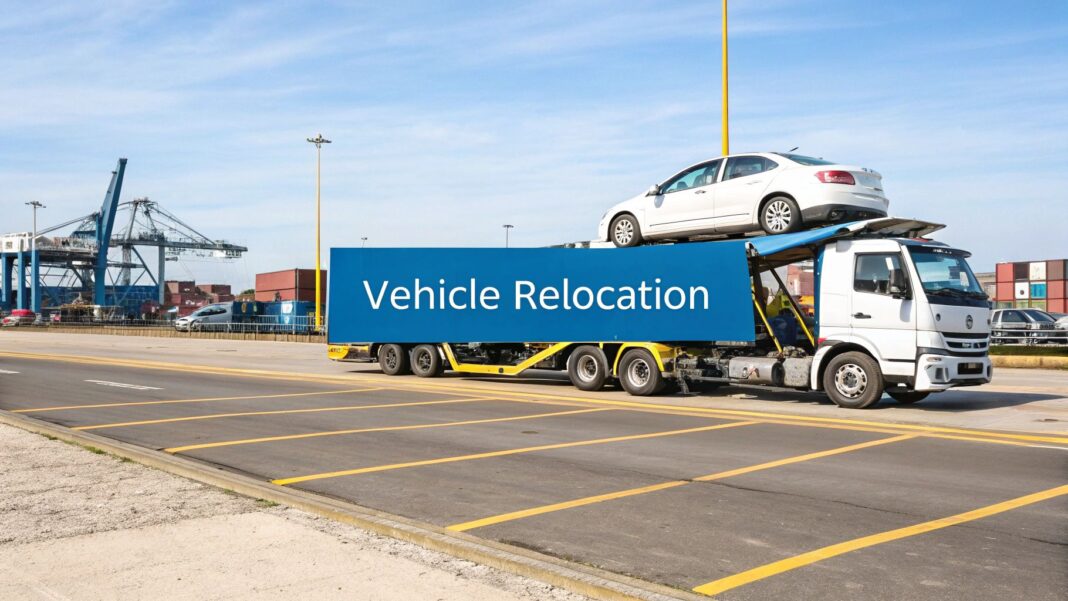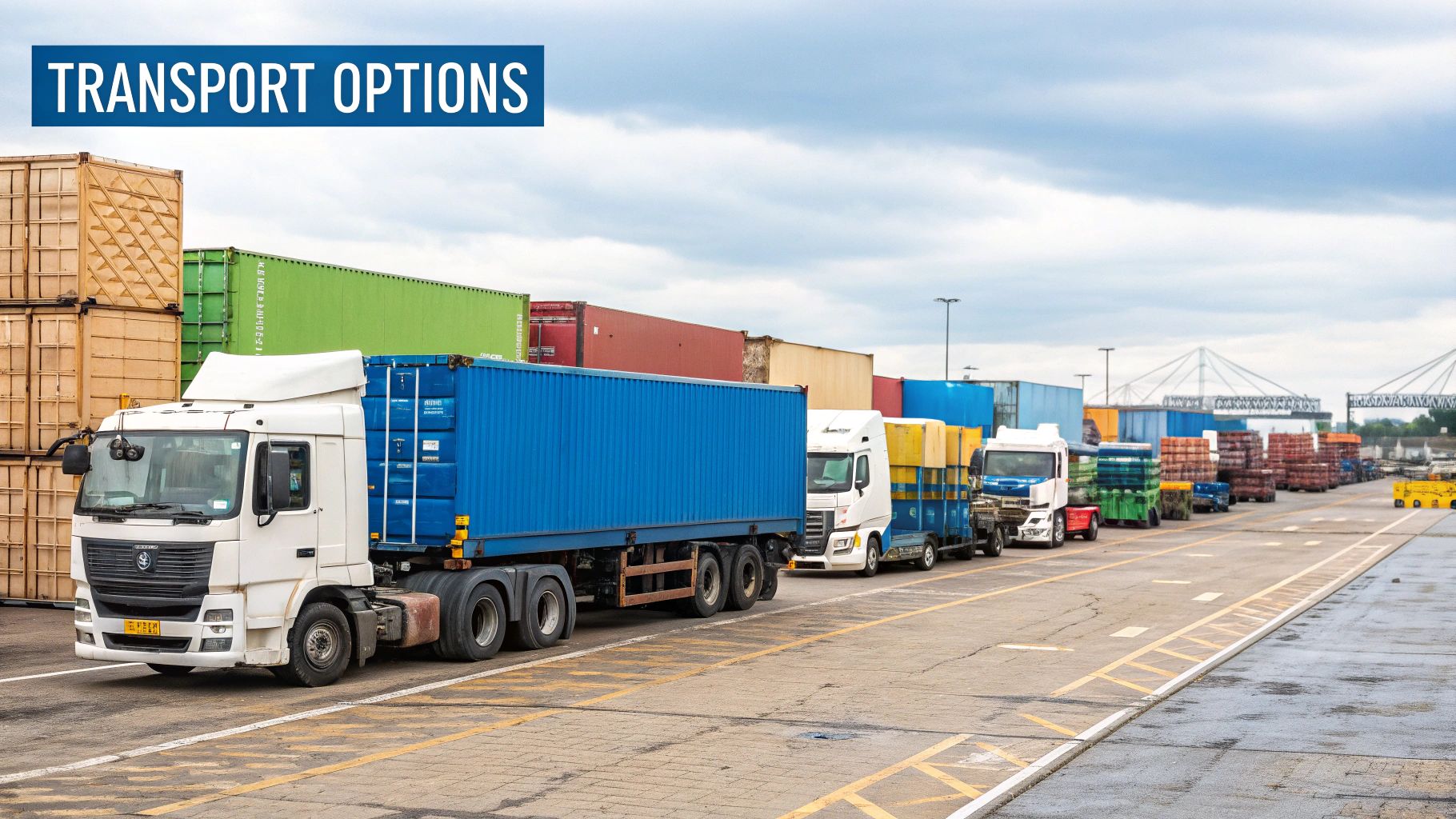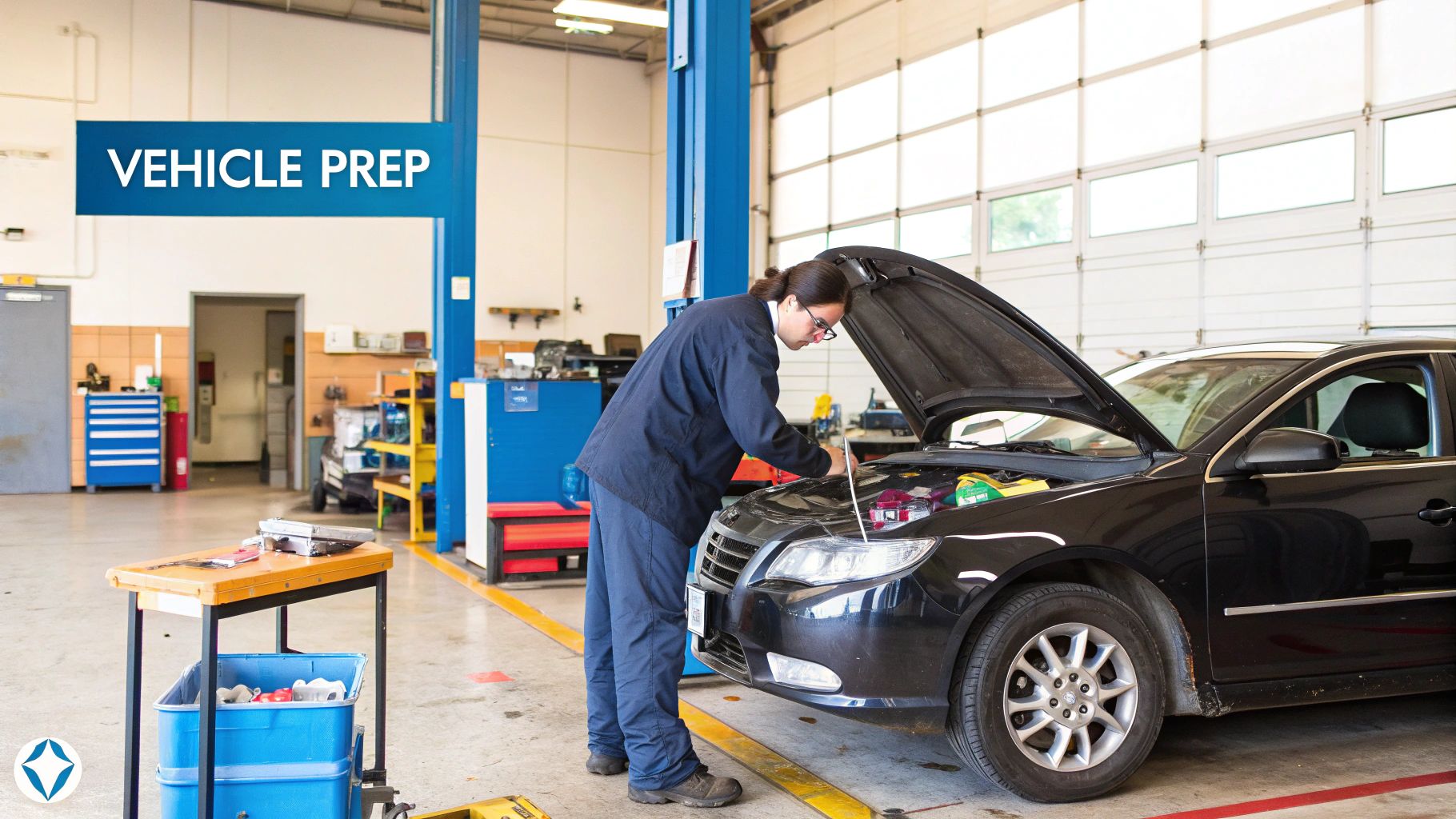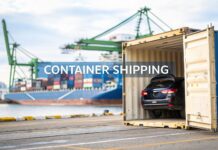
Navigating how to get your car from one side of the country to the other without driving it yourself can seem daunting. That’s where vehicle relocation services come in. This guide provides actionable insights into how these services work, helping you move your car, truck, or motorcycle efficiently and safely.
What Exactly Are Vehicle Relocation Services?
At its core, a vehicle relocation service solves the logistical challenge of moving a vehicle over a long distance without you being behind the wheel. It's a practical solution that saves you time, money, and prevents the wear and tear of a cross-country drive.
Instead of adding thousands of miles to your odometer, you entrust your vehicle to a professional. They manage the entire journey, sparing your car from road hazards and depreciation. You also bypass the direct costs of a road trip, such as fuel, lodging, and meals. Your vehicle arrives safely, protected by the carrier's insurance from pickup to delivery.
Who Benefits Most from This Service?
While anyone can use a car shipping service, it's a particularly effective solution for several specific situations. If you're facing one of these scenarios, professional transport is a smart move.
These groups often include:
- Long-Distance Movers: Relocating is complex. By outsourcing your vehicle move, you can focus on packing, coordinating movers, and settling into your new home instead of planning a multi-day drive.
- Online Car Buyers: If you've purchased a vehicle from another state, shipping it directly to you is often more time-efficient and cost-effective than flying out and driving it back yourself.
- Seasonal Travelers ("Snowbirds"): Many people who travel south for the winter use these services to transport their cars. This eliminates the need for a long, repetitive drive twice a year.
- Military Personnel: Service members receiving a Permanent Change of Station (PCS) order can use professional transporters to simplify the process of moving their personal vehicle to a new base.
In essence, vehicle relocation transforms a logistical challenge into a managed process. It's about protecting your investment—both your car and your time—by letting experts handle the long haul.
Whether you're moving, buying a car online, or just escaping the winter cold, understanding how professional car transport works is the first step. The goal is to make the process secure and efficient, allowing you to skip the stress of the open road.
Choosing Your Transport Method

Once you've decided to ship your car, the next step is choosing the transport method. The decision boils down to two main choices: open carrier or enclosed carrier transport. Each option offers a different balance of cost, protection, and availability.
Your choice should be based on your vehicle's value, your budget, and your specific needs. Understanding the practical differences between these two methods is key to making an informed decision.
H3: Open Carrier Transport: The Industry Standard
Open carrier transport is the most common and recognizable form of car shipping. These are the large, often double-decker trucks you see on the highway, carrying up to ten vehicles at a time. It is by far the most affordable method.
Because the cost is distributed among multiple vehicle owners, open transport is highly economical. Your vehicle is exposed to the elements—such as rain, sun, and road dust—just as it would be if you were driving it. This method is standard for most everyday vehicles and is how dealerships transport new cars from factories to lots.
Actionable Insight: For standard cars, SUVs, and trucks, open transport is the most practical and cost-effective solution. It is a reliable and widely available service trusted for millions of shipments annually.
H3: Enclosed Carrier Transport: The White-Glove Option
If open transport is the standard, enclosed transport is the premium service. With this method, your vehicle is loaded inside a fully covered trailer, providing complete protection from weather, road debris, and potential hazards.
This superior protection comes at a higher cost; expect to pay 30-60% more for an enclosed carrier. These specialized trailers carry fewer vehicles (typically one to seven), which increases the price per vehicle. It's the preferred choice for vehicles that require maximum security and care.
This premium service is ideal for:
- Luxury and Exotic Cars: Protects high-value paint and finishes from any external risks.
- Classic and Antique Vehicles: Shields vintage cars from elements that could cause damage.
- Race Cars: Ensures performance vehicles arrive at the track in pristine condition.
- Motorcycles: Provides a secure and stable environment, superior to an open flatbed.
When moving specialized vehicles like boats, it's crucial to understand the proper securing techniques. Consulting boat trailer guides can provide valuable information to ensure safe transport.
H3: Comparing Open and Enclosed Vehicle Transport
To make your decision, you need to balance your vehicle's value, your budget, and your need for peace of mind. Here is a direct comparison to help you choose the right service for your situation.
This table highlights the key differences between the two primary transport methods.
| Feature | Open Carrier Transport | Enclosed Carrier Transport |
|---|---|---|
| Cost | The most affordable option, great for standard budgets. | Premium pricing, typically 30-60% higher than open. |
| Protection | Exposed to weather and road debris, similar to driving. | Fully protected from all external elements and hazards. |
| Availability | High availability with more carriers and frequent routes. | Less common, may require more flexible scheduling. |
| Best For | Daily drivers, used cars, standard SUVs, and budget moves. | Classic cars, luxury vehicles, exotics, and high-value assets. |
Ultimately, the choice is yours. For a standard family sedan, open transport offers a reliable and economical solution. For a valuable classic car, the additional cost of an enclosed carrier is a worthwhile investment for complete protection.
For added convenience, door-to-door auto transport is available for both methods, simplifying the logistics by having your vehicle picked up and delivered directly to your specified locations.
How Vehicle Shipping Costs Are Calculated

When you request quotes for vehicle relocation, you'll notice prices can vary significantly between companies. A quote of $800 from one provider and $1,200 from another for the same route is common. This variation is due to several key factors that influence the final price.
Understanding these factors gives you valuable insight into the pricing structure and empowers you to make decisions that can potentially lower your overall cost. The calculation is based on both the specifics of your shipment and broader market conditions.
Core Factors That Shape Your Quote
Every shipping quote starts with four fundamental variables. These are the primary drivers of the base price.
- Distance: The mileage between pickup and delivery is the most significant factor. Longer distances mean more fuel, driver time, and potential tolls, directly increasing the cost. A 500-mile trip will be substantially cheaper than a 2,500-mile cross-country shipment.
- Vehicle Size and Weight: Larger and heavier vehicles, like a Ford F-150 or a large SUV, occupy more space and add more weight to the carrier. This limits the number of other vehicles that can be transported, so the cost is higher compared to a compact car like a Honda Civic.
- Transport Method: Your choice between open and enclosed transport directly impacts the price. Enclosed shipping offers premium protection and is a specialized service, typically costing 30-60% more than a standard open carrier.
- Vehicle Condition: A vehicle that runs and can be driven onto the carrier is standard. If your vehicle is inoperable and requires a winch for loading and unloading, an additional fee will be added to cover the extra labor and specialized equipment needed.
External Influences on Pricing
Beyond your vehicle's specifics, market forces also play a crucial role in pricing. These external variables can cause quotes to change from one week to the next.
Valuable Information: The vehicle transport market is dynamic. Pricing is influenced by supply and demand, fuel costs, and seasonal trends, much like airline tickets or other logistics services.
Seasonal demand is a major factor. The summer months are the peak season for moving, which increases demand and drives up prices. Conversely, you can often secure better rates in the fall and winter. An exception is the "snowbird" season, when demand for routes to southern states like Florida surges. These factors heavily influence the cost to ship a car to Florida during winter.
The route popularity also affects cost. Transporting a vehicle between major metropolitan areas like Los Angeles and Dallas is generally less expensive because carriers run these routes frequently, making it easier to fill their trucks. Shipping to or from a remote, rural location will almost always cost more due to the extra time and fuel required for the driver to detour from main highways.
Actionable Tips for a Better Price
With an understanding of the pricing factors, you can use these strategies to find a more competitive rate.
- Be Flexible with Your Dates: Providing a wider pickup window (e.g., 5-7 days) gives the transport company more flexibility to schedule your vehicle on a carrier already in your area. This logistical efficiency often translates into a lower price for you.
- Book in Advance: Don't wait until the last minute. Booking your transport at least two to three weeks in advance increases your chances of securing a spot at a better price before carrier availability becomes limited.
- Choose Open Transport: For most standard vehicles, open transport is the most effective way to save money. It's a safe, reliable method that meets the needs of the vast majority of customers.
Navigating the Vehicle Relocation Process
Understanding the vehicle shipping process from start to finish demystifies the experience. It follows a clear sequence of steps designed to ensure your vehicle is transported safely and efficiently.
Here's a practical roadmap of what to expect, from getting your initial quote to receiving your vehicle at its destination.
The First Steps: Finding and Booking a Provider
The process begins with research: gather quotes from several vehicle relocation services. While it's tempting to choose the lowest price, an unusually cheap quote can be a red flag. Focus instead on companies with positive customer reviews, proven experience, and verifiable credentials.
After comparing options and selecting a provider, you will book the service. This involves signing a contract that details all terms, confirming pickup and delivery addresses, and establishing a transport window.
This infographic provides a quick checklist for vetting a transport company.
As shown, making a smart choice involves looking beyond price to verify legitimacy, understand all costs, and review real customer feedback.
How to Prepare Your Car for Pickup
Once your transport is booked, you need to prepare your vehicle for its journey. These preparatory steps are essential for a smooth and safe handoff. Neglecting them can lead to delays or complications.
Follow this pre-transport checklist:
- Clean Your Vehicle: Wash the exterior. A clean car allows for an accurate inspection, making it easy to document any pre-existing scratches or dents.
- Remove All Personal Items: This is critical. Transport carriers are not licensed to transport household goods, and their insurance will not cover personal belongings. Remove all loose items, including electronics, clothing, and documents.
- Check Fluid Levels and Battery: The gas tank should be no more than a quarter full. Ensure antifreeze levels are appropriate for any climates the vehicle might pass through. The battery should be secure and charged.
- Document Its Condition: Use your smartphone to take detailed, time-stamped photographs of your vehicle from all angles, including the interior and the odometer. This creates a personal record that supplements the official inspection report.
Actionable Insight: Preparing your car properly is key to a hassle-free experience. Handing over a clean, empty vehicle ensures a professional and efficient exchange with the driver.
Vehicle shipping is often one component of a larger move. For a broader perspective on managing a major relocation, this comprehensive guide for long distance relocation offers useful tips.
The Pickup Inspection and Bill of Lading
This is one of the most crucial steps in the process. When the driver arrives, you will conduct a joint inspection of your vehicle. Every existing imperfection—scratches, dents, or scuffs—will be noted on a document called the Bill of Lading (BOL).
The BOL functions as your contract, receipt, and condition report. Review it carefully before signing. Once you and the driver agree on the vehicle's condition and sign the BOL, you will hand over the keys, and the transport process officially begins.
Delivery and Final Inspection
When the carrier arrives at the destination, you or your designated representative will meet the driver. Before you sign the final paperwork and make the final payment, you must perform a final inspection.
Using your copy of the Bill of Lading from pickup, walk around the vehicle with the driver and compare its current state to the initial report. If everything is in order and there is no new damage, you can sign the delivery receipt, pay any outstanding balance, and receive your keys. This final check concludes the transport process.
How to Choose a Reputable Car Shipping Company

Your car is a significant asset, so choosing the right company from the many vehicle relocation services available is the most important decision you'll make. It’s not about finding the lowest price; it’s about selecting a trustworthy partner who will transport your vehicle safely and professionally.
Approach this decision with the same diligence you would when hiring a contractor for a major home project. You need to verify credentials, review their track record, and look for any potential red flags.
Check Their Credentials and Insurance
The first step is to verify the company's legitimacy. All legal auto transport brokers and carriers in the United States must be registered with the Federal Motor Carrier Safety Administration (FMCSA).
You can and should use their MC/DOT number to look them up on the FMCSA website. This quick check confirms their license and provides access to their safety record and operational history. It is a simple but essential step for your peace of mind.
Next, you must verify their insurance coverage. A reputable company will readily provide a copy of their insurance certificate. This document proves their cargo insurance is active and details the coverage limits, so you know exactly what protection is in place during transit.
Read Reviews on Independent Sites
Do not rely solely on testimonials featured on a company's own website. To get an unbiased perspective, consult independent, third-party review platforms where customers share their real experiences.
Look for patterns in customer feedback on sites such as:
- Better Business Bureau (BBB): Useful for checking a company's rating and seeing how they handle customer complaints.
- Google Reviews: Provides a broad spectrum of customer experiences, both positive and negative.
- TransportReviews.com: A niche site dedicated to the auto transport industry, offering highly relevant feedback.
These reviews will reveal crucial information about their communication, reliability, and customer service—details you won't find in a sales pitch.
Watch Out for Red Flags
Knowing what to look for is important, but so is knowing what to avoid. Certain business practices are clear warning signs of a potentially unreliable operator.
Actionable Insight: An extremely low quote is a common tactic used to attract customers. These "bait-and-switch" offers often lead to hidden fees, significant delays, or poor service once you've committed.
Be alert for these red flags:
- Suspiciously Low Quotes: If a quote is significantly lower than all others, be wary. Quality transport has associated costs, and a rock-bottom price may indicate cut corners in service or insurance.
- Large Upfront Deposits: Reputable companies typically do not require a large payment before a carrier is assigned. Many require no payment until pickup is scheduled, and it's often a small, refundable deposit.
- No Written Contract: A verbal agreement is not sufficient. Always insist on a detailed contract that outlines the final cost, pickup and delivery windows, insurance coverage, and cancellation policies. This document is your primary legal protection.
Common Questions About Vehicle Relocation
Even after selecting a company, you may still have questions, especially if you're shipping a vehicle for the first time. Here are clear, practical answers to the most common queries about vehicle relocation services.
How Long Does Vehicle Shipping Usually Take?
While an exact delivery date is difficult to promise, transport times generally fall within predictable windows based on distance. Shipping a vehicle is a logistical process involving multiple pickups and drop-offs.
A regional move of a few hundred miles typically takes 2 to 5 days. A full cross-country shipment, such as from Florida to Washington, can take 7 to 14 days. This timeframe accounts for driving time, required driver rest periods, and the logistics of serving multiple customers on one route.
The carrier's route is similar to a bus route with multiple stops. The delivery timeline for your vehicle depends on where it falls in the driver's schedule of pickups and drop-offs.
Valuable Information: Your delivery date is an estimate. External factors such as weather, traffic, and unforeseen mechanical issues can affect the final arrival time. Maintain open communication with the transport company for updates.
If you have a strict deadline, ask about expedited or guaranteed pickup services. These premium options can provide a more definite schedule but come at an additional cost.
Is My Car Insured During Transport?
Yes, absolutely. All licensed and legally operating vehicle transport companies are required by federal law to carry cargo insurance. This is not an optional add-on but a fundamental requirement of their business.
This insurance covers damage to your vehicle caused by carrier negligence during transport. Before you commit, always ask for a copy of their certificate of insurance. This document confirms their coverage is active and allows you to review the policy limits.
It is also a good practice to contact your personal auto insurance provider. Some policies offer supplemental coverage when your vehicle is being transported. Knowing your full coverage provides extra peace of mind. Remember, the Bill of Lading signed at pickup is the crucial document for verifying your car's initial condition in the event of a claim.
Can I Pack Personal Items Inside My Car?
The standard industry rule is no. While it may seem convenient to use your vehicle for extra storage, there are compelling reasons why this is prohibited.
First, auto carriers are licensed by the Department of Transportation to transport vehicles only, not household goods. If a carrier is found to be transporting personal items during an inspection, they can face substantial fines.
More importantly for you, the carrier's cargo insurance does not cover personal belongings.
- Any items you pack in your car—such as electronics, clothes, or personal documents—are not insured against loss, theft, or damage during transit.
- The extra weight of personal items can also pose a safety risk and may cause the transport truck to exceed its legal weight limit, leading to fines and delays.
While some companies may permit a single box or suitcase under 100 lbs in the trunk, you must get explicit, written permission first. The safest and recommended approach is to ship a completely empty vehicle.
What Is the Bill of Lading and Why Does It Matter?
The Bill of Lading (BOL) is the most important document in the vehicle shipping process. It serves as your receipt, inspection report, and the binding contract between you and the carrier.
You will interact with the BOL at two key moments:
- At Pickup: You and the driver will inspect the vehicle together, noting every pre-existing mark, scratch, or dent on a vehicle diagram on the BOL. By signing it, you both agree on the vehicle's initial condition.
- At Delivery: Before accepting the vehicle, you must conduct a final inspection. Using your copy of the BOL, you compare the vehicle's current condition to the report made at pickup.
This final inspection is your opportunity to identify any new damage that may have occurred during transit. Any new damage must be noted on the BOL before you sign the delivery receipt. A signed BOL without any new damage noted confirms you have received the vehicle in satisfactory condition and closes the contract. Be thorough during this final check—it is your primary tool for protection.
When you're ready to move your vehicle with confidence, trust the experts at We Will Transport It. Our team is dedicated to providing secure, reliable, and transparent shipping solutions for any vehicle, anywhere in the country. Get your free, no-obligation quote today and see how easy vehicle relocation can be by visiting us at https://www.wewilltransportit.com.





